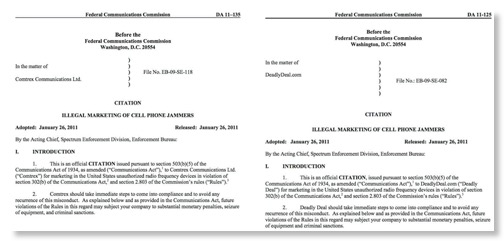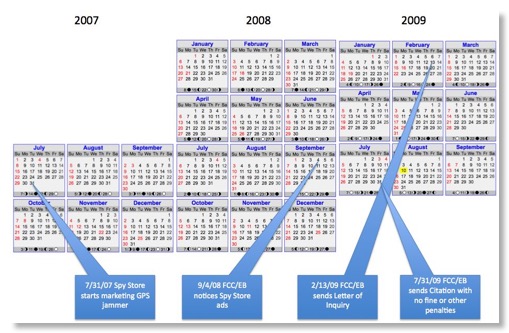Recent EB Action Shows Slowness of Title III Technical Enforcement
27 01, 11 15:46 Filed in: Prison Jamming Issue | enforcement

On January 26, 2011, the Commission released two citations, shown above, for the marketing of cellular telephone jammers. Although your blogger has argued here that the Commission has the authority to authorize the use of cell phone jammers in prisons if it adopted new rules, it is unambiguous that the jammers being sold here were illegal because they had not equipment authorization and thus selling them violated Section 302 of the Communications Act.
In August 2009, I wrote here about an enforcement case involving the sale of a GPS jammer. At the time I used the following calendar to show the foot dragging involved in this action:

So how has timeliness improved? Note that in both the GPS and cell phone cases there was no question that the devices being sold were illegal and the sale violated Section 302. Note that violations of Section 302 are a misdemeanor and punishable as a criminal act under Section 501.
The two companies involved in the citation were DeadlyDeal.com and Comtrex Communications Ltd. Reading the citations carefully one sees that FCC was aware of DeadlyDeal.com’s marketing at least by April 8, 2009, yet did not even communicate with the company until February 18, 2010, 325 days later. In the case of Comtrex Communications Ltd., FCC was aware of the marketing at least by by June 9, 2009 and sent the first communications to the company September 29, 2009, 112 days later.
But both the GPS case and the present cellular cases ended up the same way with citations with no explicit penalty, except perhaps postage to respond to FCC letters. What type of deterrent is this for future illegal marketing by others?
On January 25, I gave an invited talk at the FCBA FCC Enforcement Brown Bag Lunch on the subject on unlicensed devices and enforcement. Here are the slides I used. I made the point that ever since the reorganization of the former FOB into Enforcement Bureau, the technical staff there has suffered from poor morale and poor leadership and that incumbent spectrum users need to advocate for more effective enforcement and leadership or major interference problems are likely to arise. This dilatory indecisive action in both the GPS jammer case and the cellular jamming case highlights how large numbers of interference causing devices could enter the marketplace before FCC takes any action. I urge the major spectrum incumbents and their trade associations to engage FCC senior leadership on how unacceptable this indecision is and the risks that result from it.
Furthermore, the lack of credible enforcement leads incumbents and NTIA to be reluctant to allow new technology near their bands for fear that noncompliant equipment will cause interference and there will be no timely FCC action. Thus the compliance status quo actually limits the Commission’s Title III policy options for new technologies!
IT GETS STRANGER!
Shortly after this was posted, Steve Crowley sent a comment to the blog pointing out that on the same day EB issued these 2 citations it issued a $10,000 NAL (fine) to an Arizona car dealer for unlicensed use of GMRS, a CB-like radio service than needs a license. Steve asks, “Is that worse than selling illegal jammers?”
So not only did EB act more promptly in the GMRS case than in the cell phone jamming cases and the GPS jamming case, they took decisive enforcement action rather than the toothless citation issued for these 3 jamming equipment cases. Where does CTIA and its membership stand on this type of enforcement? Should the 8th Floor ask for an explanation?
====
On a side issue, both the citations have this paragraph in them:
Jamming devices, however, cannot be certified or authorized because the main purpose of a jamming device is to block or interfere with radio communications. As noted above, such use is clearly prohibited by section 333 of the Communications Act. Thus, cell phone jammers, such as the Blocker, cannot comply with the FCC’s technical standards and therefore cannot be marketed in the United States.
This is the CTIA party line on its preferred interpretation of Section 333. The paragraph in the citations has no references to Commission decisions or court cases because there are none on this issue. This interpretation shows up in staff actions taken on delegated authority and in the case of these specific citation is irrelevant because sale of the devices violated Section 302 regardless of what Section 333 means. Their inclusion here is either because of ignorance or a desire to pander to CTIA. Repeating the same interpretation does not make it correct! The Commission has been sitting on the petition of South Carolina and 30 other states for over a year now. If this was such a clear issue they would have dismissed the petition per Section 1.401(e) of the FCC Rules months ago.
blog comments powered by Disqus



![Validate my RSS feed [Valid RSS]](valid-rss-rogers.png)

